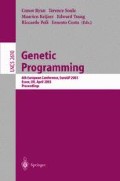Abstract
Precocious diagnosis increases the survival time and patient quality of life. It is a binary classification, exhaustively studied in the literature. This paper innovates proposing the application of genetic programming to obtain a discriminate function. This function contains the disease dynamics used to classify the patients with as little false negative diagnosis as possible. If its value is greater than zero then it means that the patient is ill, otherwise healthy. A graphical representation is proposed to show the influence of each dataset attribute in the discriminate function. The experiment deals with Breast Cancer and Thrombosis & Collagen diseases diagnosis. The main conclusion is that the discriminate function is able to classify the patient using numerical clinical data, and the graphical representation displays patterns that allow understanding of the model.
Access this chapter
Tax calculation will be finalised at checkout
Purchases are for personal use only
Preview
Unable to display preview. Download preview PDF.
References
Newman, M.; “UK’s cancer death rate is worst in the world”; Metro News, Tuesday, July 2, 2002.
Kononenko, I.; “Machine learning for medical diagnosis: history, state of the art and perspective”; Artificial Intelligence in medicine 23:89–109, 2001.
West, D; West, V; “Model selection for a medical diagnostic decision support system: a breast cancer detection case” Artificial Intelligence in medicine 20(2000)183–204.
Setiono, R.; “Extracting rules from pruned neural networks for breast cancer diagnosis” Artificial Intelligence in Medicine 8(1):37–51, 1996.
Setiono, R.; “Generating concise and accurate classification rules for breast cancer diagnosis”; Artificial Intelligence in medicine 18:205–219, 2000
Flach, P.A.; “On the state of art in machine learning: a personal review”; Artificial Intelligence 131:199–222, 2001.
Joachins, T.; “Tutorial Support Vector Machines” In Internet http://www.afia.polytechnique.fr/CAFE/ECML01/SVM.html
Land Jr., W.H.; Lo, J.Y.; Velazquez, R.; “Using evolutionary programming to configure support vector machine for the diagnosis of breast cancer”. In Dagli, C.H. et al (Eds) Intelligent engineering systems through artificial neural networks ANNIE’2002, Volume 12, Smart engineering system design, ASME Press, New York, 2002.
Pendharkar, P.C.; et al; “Association, statistical, mathematical and neural approaches for mining breast cancer patterns”; Expert Systems with Applications 17:223–232, 1999.
Nauck, D.; Kruse, R.; “Obtaining interpretable fuzzy classification rules from medical data”; Artificial intelligence in medicine 16:149–169, 1999
Freitas, A.A.; “Data mining and knowledge discovery with Evolutionary Algorithms”; Springer 2002.
Pena-Reyes, C.A.; Sipper, M.; ℝdA fuzzy-genetic approach to breast cancer diagnosis”; Artificial intelligence in medicine 17:131–155, 1999.
HOLLAND, J.H. “Adaptation in natural and artificial systems: na introductory analysis with applications to biology, control and artificial intelligence.” Cambridge: Cambridge press 1992.
GOLDBERG, D.E. “Genetic Algorithms in Search, Optimisation, and Machine Learning.” Reading, Mass.: Addison-Whesley, 1989.
CHAMBERS, L.; “The practical handbook of Genetic Algorithms” Chapman & Hall/CRC, 2000.
KOZA, J.R. “Genetic programming: On the programming of computers by means of natural selection.” Cambridge,Mass.: MIT Press, 1992.
LilGP “Genetic Algorithms Research and Applications Group (GARAGe)”, Michigan State University; http://garage.cps.msu.edu/software/lil-gp/lilgp-index.html
Bradley, A.P.; “The use of the area under the ROC curve in the evaluation of machine learning algorithms”; Pattern Recognition, 30(7):1145–1159, 1997.
WDBC Dr. William H. Wolberg, General Surgery Dept.,; W. Nick Street, Computer Sciences Dept.; Olvi L. Mangasarian, Computer Sciences Dept.; University of Wisconsin http://www.ics.uci.edu/~mlearn/MLRepository.html
Werner, J.C.; Fogarty, T.C.; “Severe diseases diagnostics using Genetic Programming.” Intelligent Data Analysis in medicine and pharmacology-IDAMAP2001; September 4th, 2001 London http://magix.fri.uni-lj.si/idamap2001/scientific.asp
5th European Conference on Principles and Practice of Knowledge Discovery in Databases (PKDD’01) Challenge on Thrombosis data-Germany/ Freiburg September 3–7, 2001
Werner, J.C.; Fogarty, T.C.; “Genetic programming applied to Collagen disease & thrombosis.” in PKDD 2001 Challenge on Thrombosis data-Germany/ Freiburg September 3–7, 2001.
Author information
Authors and Affiliations
Editor information
Editors and Affiliations
Rights and permissions
Copyright information
© 2003 Springer-Verlag Berlin Heidelberg
About this paper
Cite this paper
Werner, J.C., Kalganova, T. (2003). Disease Modeling Using Evolved Discriminate Function. In: Ryan, C., Soule, T., Keijzer, M., Tsang, E., Poli, R., Costa, E. (eds) Genetic Programming. EuroGP 2003. Lecture Notes in Computer Science, vol 2610. Springer, Berlin, Heidelberg. https://doi.org/10.1007/3-540-36599-0_44
Download citation
DOI: https://doi.org/10.1007/3-540-36599-0_44
Published:
Publisher Name: Springer, Berlin, Heidelberg
Print ISBN: 978-3-540-00971-9
Online ISBN: 978-3-540-36599-0
eBook Packages: Springer Book Archive

